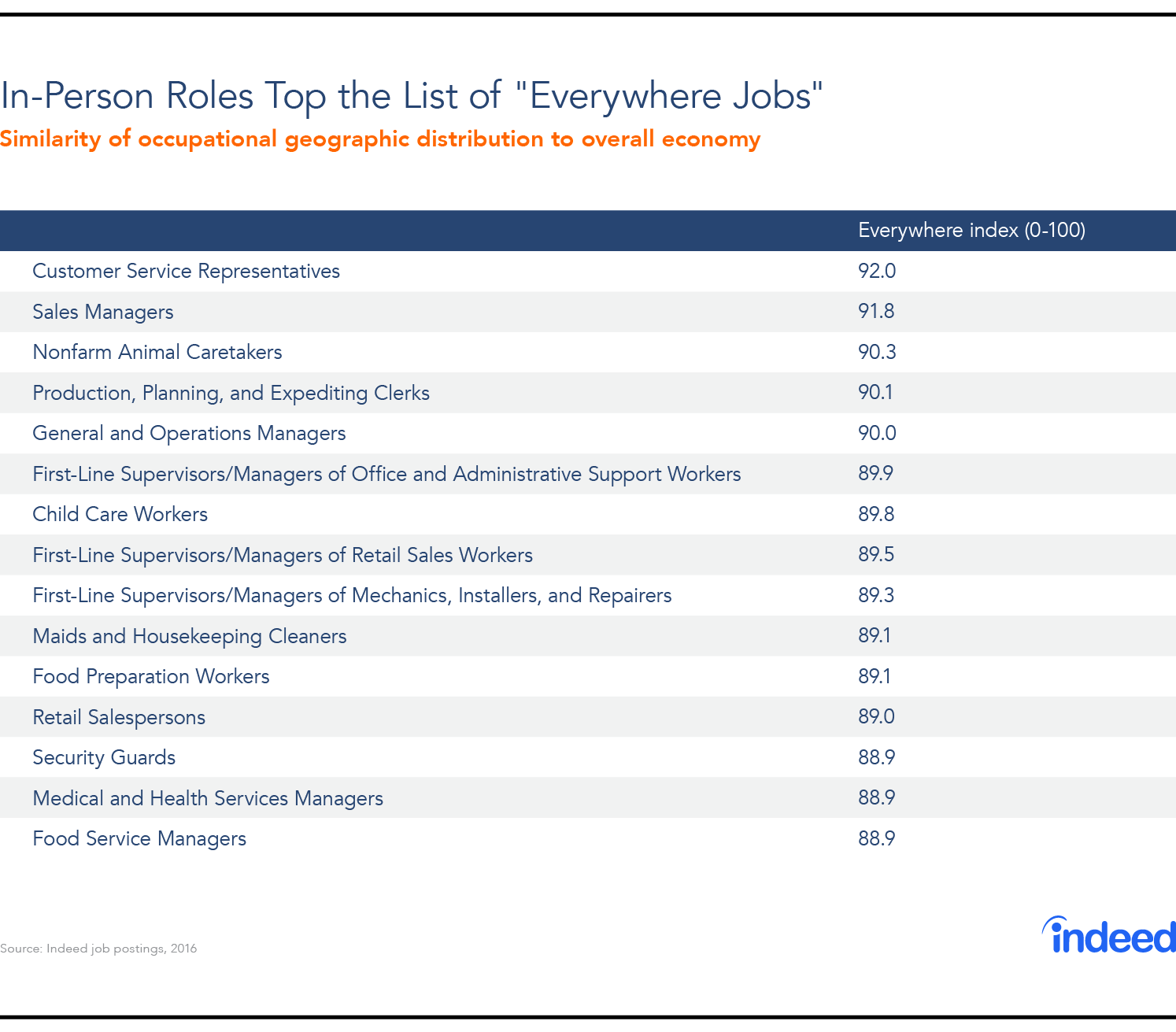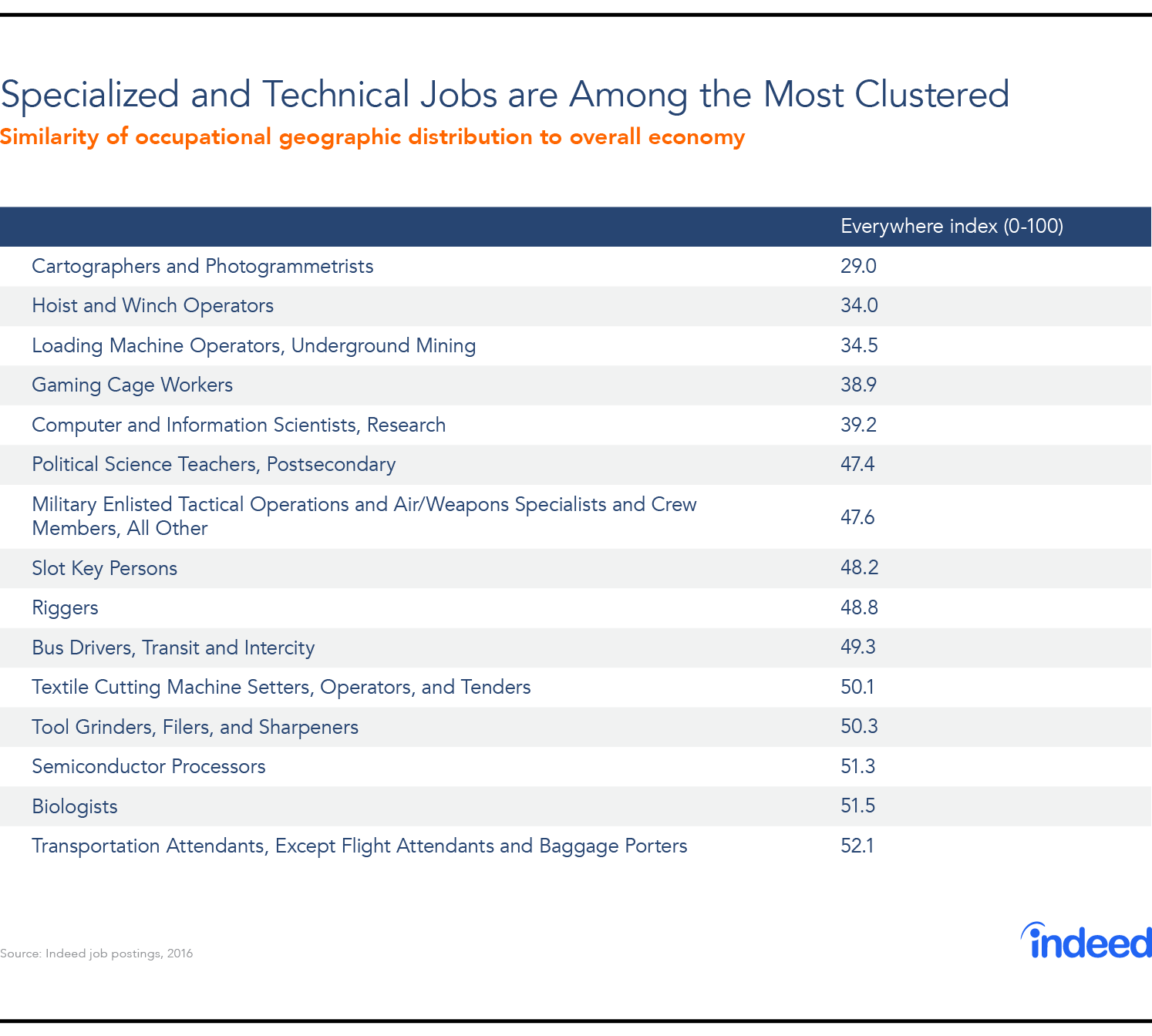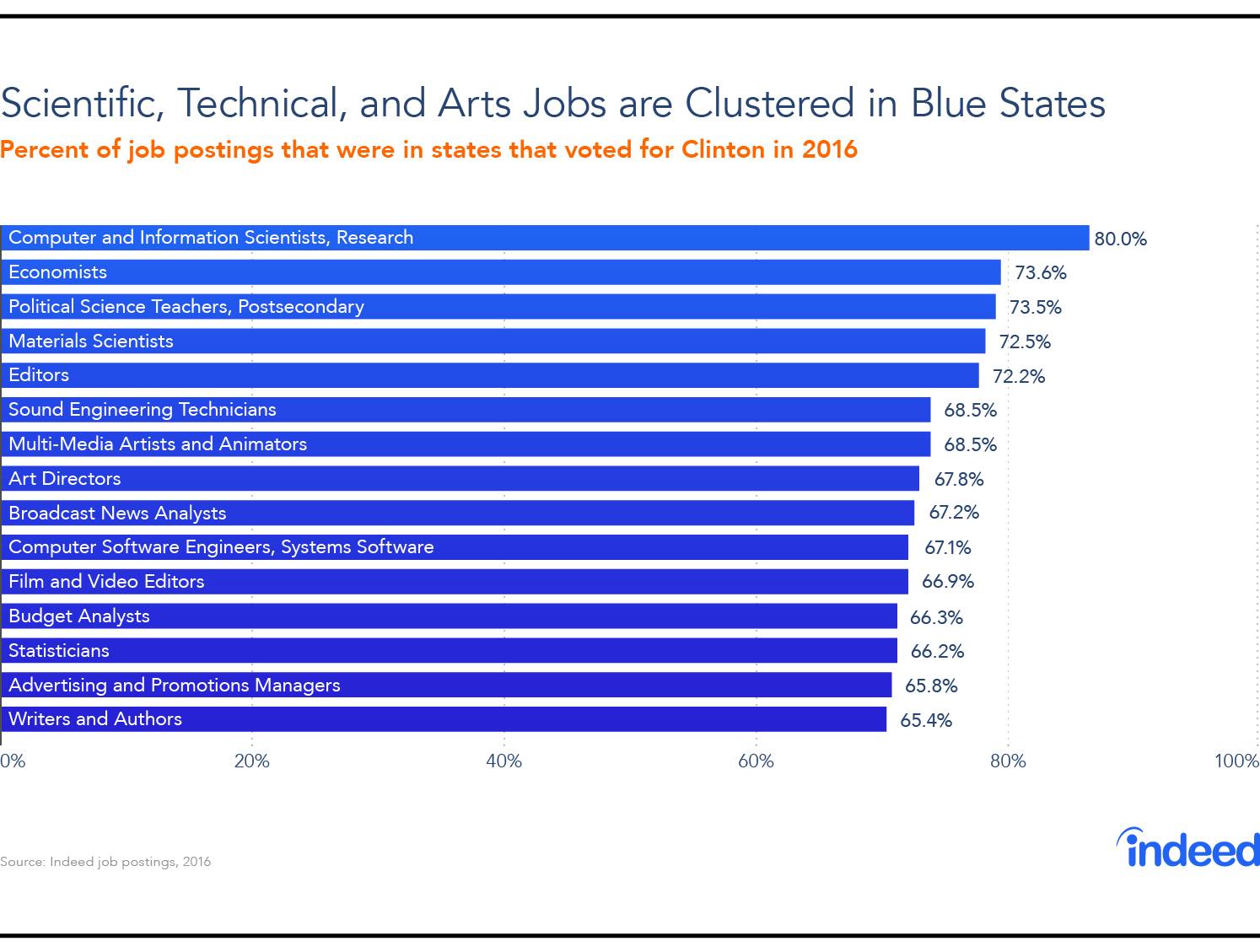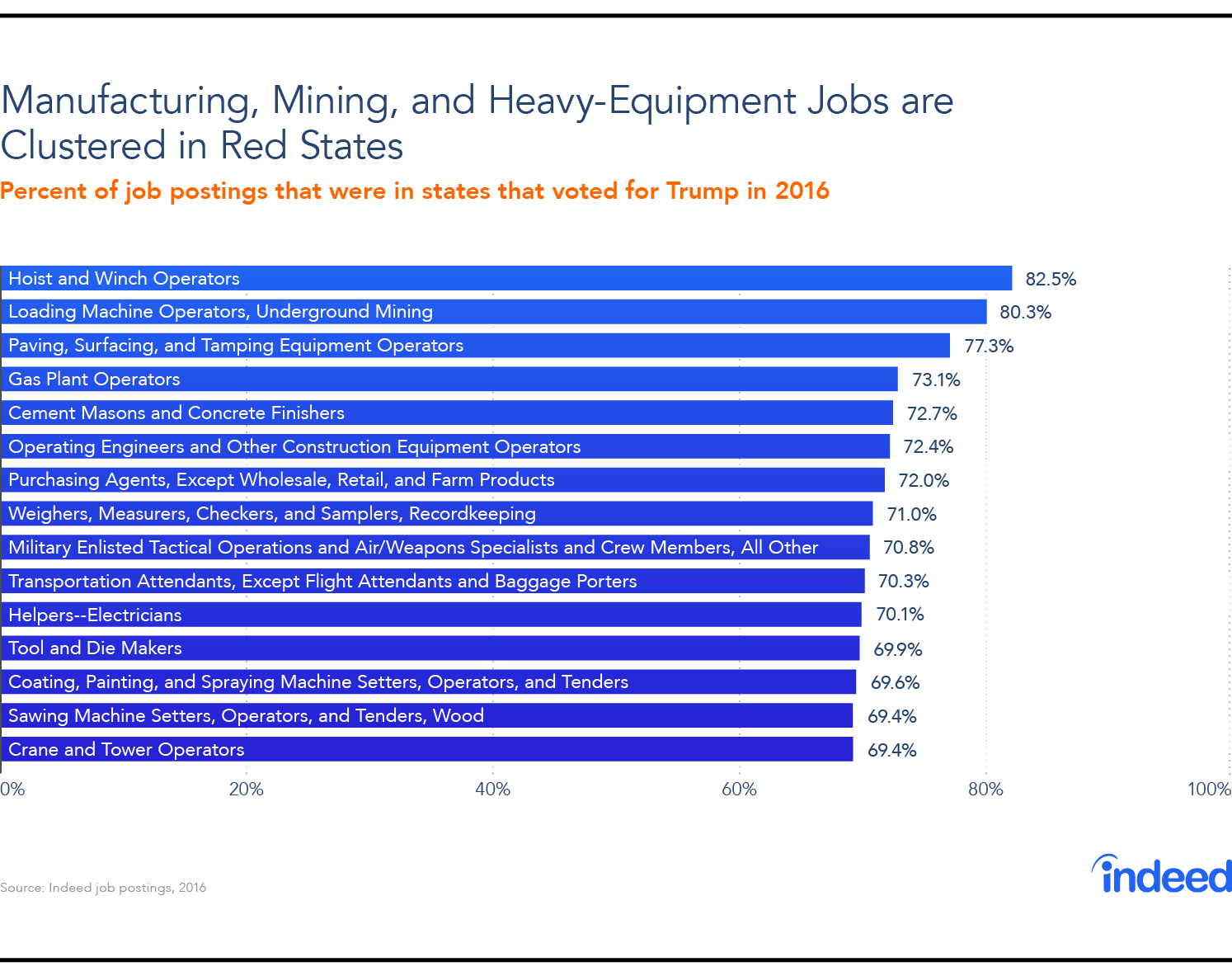Your job might determine where you live, and where you live might decide what work you do. Many jobs and industries cluster in specific places. We all know that movies are in Los Angeles, finance is in New York, and oil drilling is wherever the oil is, but other industries have traditionally clustered as well— like carpet-making in northern Georgia, musical instruments in Elkhart, Indiana, and costume jewelry in Providence, Rhode Island.
Jobs cluster in particular places for many reasons. Some industries, like mining or transportation, need to be near natural resources like oil in the ground or a port. Some clusters begin around a university or even randomly but get reinforced over time if clustering boosts economic productivity or provides workers with a form of insurance (if you lose your job, there’s a similar one nearby).
Still, not all jobs cluster. Many show no special geographic pattern: they exist wherever people live. We call these “everywhere jobs.” They are occupations that you might be able to find wherever you are — which is a big plus if, because of personal or family reasons, you might be tied to a particular place or have to move to a new one.
Looking at the tens of millions of jobs posted on Indeed in the U.S. at any time in 2016, we identified which occupations are the most clustered in particular places and which, in contrast, are everywhere jobs, with no particular geographic pattern. We calculated an index for each occupation that shows how geographically similar it is to U.S. employment overall. The index equals 100 if an occupation’s geographical pattern is identical to that of U.S. jobs generally. The next section looks at the everywhere jobs versus the most clustered jobs. Then, the following section takes a closer look at jobs that cluster in a particular way, along red-state/blue-state lines.
Everywhere Jobs vs. Clustered Jobs
If you want a job that doesn’t tie you to a particular place, it helps to be good with people. The jobs that are found nearly everywhere include customer service reps, sales managers, retail salespeople, and childcare workers. Being good with pets helps, too: nonfarm animal caretakers score high on the everywhere index. Other everywhere jobs include maids and housekeeping cleaners, food prep and food service, and security guards. Several managerial and supervisory roles are found nearly everywhere, too: these are among the better-paying everywhere jobs.

A commonality across many of these everywhere jobs is that they involve working with customers face-to-face or on-site. They are jobs that are needed wherever people (and their pets and children) live: in urban and in rural areas, and in all regions of the country. Everywhere jobs tend not to be highly technical or specialized, though there are some technical or specialized jobs that have a very high everywhere index but not quite high enough to make the top-fifteen list, such as administrative law judges, clerks, and hearing officers, as well as computer support specialists and medical technicians.
In comparison, occupations ranking low on the everywhere index — which means they are more clustered in specific places — are an eclectic bunch. Cartographers and photogrammetrists top the list: these are experts in geography and mapping, for whom job openings are concentrated in the Washington, DC, area. Hoist and winch operators are also highly clustered, particularly in the non-metropolitan parts of Pennsylvania and Ohio; this is one of several heavy-equipment occupations related to mining, construction, or transportation that tend to be found in specific places. Many highly specialized professions are also quite clustered, like computer and information science researchers; post-secondary political science teachers; and biologists. Gaming jobs are as well — naturally they show a strong concentration in the Las Vegas area.

Cartographers and hoist and winch operators may be similar in that neither occupation is an everywhere job, but it’s hard to imagine other ways in which those two occupations are alike.
To make better sense of jobs that tend to be located in particular places rather than everywhere, it helps to look at occupations that tend to cluster in the same places. The next section of this post looks at which jobs cluster in red states (those that voted for President Trump) and blue states (those that voted for Hillary Clinton), which will surface some clear patterns in where certain types of jobs are located.
Red Jobs vs. Blue Jobs
We look at jobs in red states and blue states because the 2016 election reinforced how the economy and the job market are increasingly polarized politically. Counties that voted for President Trump have slower job growth, less-educated workforces, and a higher share of jobs that are at risk from automation — all of which could contribute to greater economic anxiety. Furthermore, President Trump has emphasized policies to boost job growth in struggling industries and places, which prompted one economist to describe “Trumponomics” as a redistribution of wealth toward places that supported Trump.
For every occupation, we calculated the share of job postings in 2016 on Indeed that were in red states or blue states. Across all occupations, 54% of postings were in the 30 red states, and the rest were in the 20 blue states plus the District of Columbia.
The reddest jobs are those related to mining, construction, and manufacturing, particularly jobs involving heavy equipment. Four-fifths of hoist and winch operator jobs and underground-mining loading machine operator jobs are in red states. Even the technical and clerical jobs that are most concentrated in red states, like purchasing agents and recordkeeping weighers and measurers, are jobs often found in manufacturing and transportation firms.

There are many professional occupations that skew toward red states. Job openings for nurses, doctors, and many other medical specialties (though not medical scientists) are more common in red states because their residents are, on average, older and therefore have greater medical needs. Zoologist and wildlife biologists, along with petroleum engineers, are also red-state jobs, since those jobs are rarer in urban areas, which voted strongly blue. Finally, three-fifths of job postings for clergy were in red states.
What about the bluest jobs? Eighty percent of computer and information-science researcher job postings are in blue states, as are two-thirds of computer systems software engineers. Number-crunchers are blue, including economists, budget analysts, and statistician postings. So are word-wranglers: editors and writers are among the bluest jobs. Several arts-and-entertainment related jobs also skew toward blue states, including art directors, multi-media artists, sound technicians, and film and video editors. Blue-state jobs generally pay more than red-state jobs, though graphic designers and proofreaders are blue-state occupations with lower earnings.

Many of these jobs are not only in blue states, but are clustered in a handful of big, expensive coastal metropolitan areas. Half of job postings for economists, editors, postsecondary political science teachers, and computer and information-science researchers are in the New York, Boston, Washington, San Francisco, and Los Angeles metro areas, as are more than 40% of graphic designers, commercial and industrial designers, writers and authors, and several film, video, and multi-media occupations. Extreme concentration of industries can affect what people produce: for instance, some have argued that the clustering of journalism jobs in these coastal cities might have contributed to liberal bias and myopia. Concentration in these cities can also limit opportunities for people who want to enter these careers but, despite generally higher salaries, can’t afford the high cost of living in these metros.
Most occupations, however, can be readily found in states on both sides of the political map. Nearly three-quarters of job postings are in occupations that are fairly balanced between red and blue states, having at least 40% of jobs in each. And, by definition, the “everywhere jobs” don’t skew red or blue because they don’t have any particularly strong geographic pattern. These are jobs that might let you choose where you live for other reasons, rather than having to move to where your career takes you.







